The Development of Copper Clad Laminate Horn Antennas for Drone Interferometric Synthetic Aperture Radar
Abstract
1. Introduction
2. Materials and Methods
2.1. Design
2.1.1. Centre Frequency
2.1.2. Pin-Fed Waveguide
2.1.3. Horn Aperture
2.2. Simulation
2.3. Fabrication
2.4. Testing
2.4.1. Vector Network Analyser
2.4.2. Anechoic Chamber
2.4.3. S11
2.4.4. Gain
2.4.5. Radiation Pattern
2.5. Incorporation into the Drone Radar Payload
3. Results
3.1. Testing Results
3.1.1. S11
3.1.2. Gain
3.1.3. Azimuth Radiation Pattern and HPBW
3.2. Drone Radar Payload
4. Discussion
5. Conclusions
- The first demonstration of horn antennas fabricated from CCL, highlighting the potential for this inexpensive material to be utilised for antenna fabrication. The combination of a lightweight dielectric substrate with a smooth and conductive copper coating at a thickness of multiple skin depths produces antennas that are suitable for drone deployment, with sufficient performance metrics for our applications.
- The identification of manufacturing processes for CCL antennas that impact the performance metrics, including the internal soldering patterns and input feed material.
- The first complete overview of custom antenna production for drone radar deployment, including incorporation into the drone payload, thus demonstrating a hardware solution in the emerging field of drone SAR and InSAR research.
Author Contributions
Funding
Institutional Review Board Statement
Informed Consent Statement
Data Availability Statement
Acknowledgments
Conflicts of Interest
References
- Uys, D. InSAR: An introduction. Preview 2016, 182, 43–48. [Google Scholar] [CrossRef]
- Wang, Z.; Lawrence, J.; Ghail, R.; Mason, P.; Carpenter, A.; Agar, S.; Morgan, T. Characterizing Micro-Displacements on Active Faults in the Gobi Desert with Time-Series InSAR. Appl. Sci. 2022, 12, 4222. [Google Scholar] [CrossRef]
- Massonnet, D.; Rossi, M.; Carmona, C.; Adagna, F.; Peltzer, G.; Feigl, K.; Rabaute, T. The displacement field of the Landers earthquake mapped by radar interferometry. Nature 1993, 364, 138–142. [Google Scholar] [CrossRef]
- Feigl, K.; Sarti, F.; Vadon, H.; McClusky, S.; Ergintav, S.; Durland, P.; Bürgmann, R.; Rigo, A.; Massonnet, D.; Reilinger, R. Estimating slip distribution for the Izmit mainshock from coseismic GPS, ERS-1, RADARSAT and SPOT measurements. Bull. Seismol. Soc. Am. 2002, 92, 138–160. [Google Scholar] [CrossRef]
- Fielding, E.J.; Talebian, M.; Rosen, P.A.; Nazari, H.; Jackson, J.A.; Ghorashi, M.; Walker, R. Surface ruptures and building damage of the 2003 Bam, Iran, earthquake mapped by satellite synthetic aperture radar interferometric correlation. J. Geophys. Res. 2005, 110, 1–15. [Google Scholar] [CrossRef]
- Fattahi, H.; Amelung, F. InSAR observations of strain accumulation and fault creep along the Chaman Fault system, Pakistan and Afghanistan. Geophys. Res. Lett. 2016, 43, 8399–8406. [Google Scholar] [CrossRef]
- Cavalié, O.; Lasserre, C.; Doin, M.P.; Peltzer, G.; Sun, J.; Xu, X.; Shen, Z.K. Measurement of interseismic strain across the Haiyuan fault (Gansu, China), by InSAR. Earth Planet. Sci. Lett. 2008, 275, 246–257. [Google Scholar] [CrossRef]
- Aditiya, A.; Aoki, Y.; Anugrah, R.D. Surface deformation monitoring of Sinaburg volcano using multi temporal InSAR method and GIS analysis for affected area assessment. IOP Conf. Ser. Mater. Sci. Eng. 2018, 344, 012003. [Google Scholar] [CrossRef]
- Massonnet, D.; Briole, P.; Arnaud, A. Deflation of Mount Etna monitoring by spaceborne radar interferometry. Nature 1995, 375, 567–570. [Google Scholar] [CrossRef]
- Amelung, F.; Jónsson, S.; Zebker, H.; Segall, P. Widespread uplift and trap door faulting on Galápagos volcanoes observed with radar. Nature 2000, 407, 993–996. [Google Scholar] [CrossRef]
- Liu, P.; Li, Z.; Hoey, T.; Kincal, C.; Zhang, J.; Zeng, Q.; Muller, J.P. Using advanced InSAR time series techniques to monitor landslide movements in Badong of the Three Gorges region, China. Int. J. Appl. Earth Obs. Geoinf. 2013, 21, 253–264. [Google Scholar] [CrossRef]
- Bianchini, S.; Pratesi, F.; Nolesini, T.; Casagli, N. Building deformation assessment by means of persistent scatterer interferometry analysis on a landslide-affected area: The Volterra (Italy) case study. Remote Sens. 2015, 7, 4678–4701. [Google Scholar] [CrossRef]
- Carla, T.; Intrieri, E.; Raspini, F.; Bardi, F.; Farina, P.; Ferretti, A.; Colombo, D.; Novali, F.; Casagli, N. Perspectives on the prediction of catastrophic slope failures from satellite InSAR. Sci. Rep. 2019, 9, 14137. [Google Scholar] [CrossRef] [PubMed]
- Velasco, V.; Sanchez, C.; Papoutsis, I.; Antoniadi, S.; Kontoes, C.; Aifantopoulou, D.; Paralykidis, S. Ground deformation mapping and monitoring of salt mines using InSAR technology. In Proceedings of the Solution Mining Research Institute (SMRI) Fall 2017 Technical Conference, Münster, Germany, 25–26 September 2017. [Google Scholar]
- Akçin, H.; Degucci, T.; Kutoglu, H.S. Monitoring mining induced subsidence using GPS and InSAR. In Proceedings of the XXIII International FIG Congress, Munich, Germany, 8–13 October 2006. [Google Scholar]
- Milillo, P.; Giardina, G.; De Jong, M.J.; Perissin, D.; Milillo, G. Multi-temporal InSAR structural damage assessment: The London crossrail case study. Remote Sens. 2018, 10, 287. [Google Scholar] [CrossRef]
- Giardina, G.; Milillo, P.; De Jong, M.J.; Perissin, D.; Milillo, G. Evaluation of InSAR monitoring data for post-tunelling settlement damage assessment. Struct. Control. Health Monit. 2019, 26, e2285. [Google Scholar] [CrossRef]
- Bakon, M.; Perissin, D.; Lazecky, M.; Papco, J. Infrastructure Non-Linear Deformation Monitoring Via Satellite Radar Interferometry. Proc. Technol. 2014, 16, 294–300. [Google Scholar] [CrossRef]
- Tarchi, D.; Rudolf, H.; Luzi, G.; Chiarantini, L.; Coppo, P.; Sieber, A.J. SAR Interferometry for Structural Changes Detection: A Demonstration Test on a Dam. In Proceedings of the IEEE 1999 International Geoscience and Remote Sensing Symposium. IGARSS’99 (Cat. No. 99CH36293), Hamburg, Germany, 28 June–2 July 1999. [Google Scholar]
- Chang, L. Monitoring Civil Infrastructure Using Satellite Radar Interferometry. Doctoral Thesis, Delft University of Technology, Delft, The Netherlands, 2015. [Google Scholar]
- Cigna, F.; Banks, V.J.; Donald, A.W.; Donohue, S.; Graham, C.; Hughes, D.; McKinley, J.M.; Parker, K. Mapping Ground Instability in Areas of Geotechnical Infrastructure Using Satellite InSAR and Small UAV Surveying: A Case Study in Northern Ireland. Geosciences 2017, 7, 51. [Google Scholar] [CrossRef]
- Ge, D.; Wang, Y.; Zhang, L.; Xia, Y.; Wang, Y.; Guo, X. Using permanent scatterer InSAR to monitor land subsidence along High Speed Railway-the first experiment in China. ESA Spec. Publ. 2010, 677, 75. [Google Scholar]
- Hu, F.; Leijen, F.J.V.; Chang, L.; Wu, J.; Hanssen, R.F. Monitoring deformation along railway systems combining multi-temporal InSAR and LiDAR data. Remote Sens. 2019, 11, 2298. [Google Scholar] [CrossRef]
- Gray, P.C.; Ridge, J.T.; Poulin, S.K.; Seymour, A.C.; Schwantes, A.M.; Swenson, J.J.; Johnston, D.W. Integrating drone imagery into high resolution satellite remote sensing assessments of estuarine environments. Remote Sens. 2018, 10, 1257. [Google Scholar] [CrossRef]
- Casagli, N.; Frodella, W.; Morelli, S.; Tofani, V.; Ciampalini, A.; Intrieri, E.; Raspini, F.; Rossi, G.; Tanteri, L.; Lu, P. Spaceborne, UAV and ground-based remote sensing techniques for landslide mapping, monitoring and early warning. Geoenviron. Disasters 2017, 4, 9. [Google Scholar] [CrossRef]
- Donnellan, A.; Green, J.; Ansar, A.; Muellerschoen, R.; Parker, J.; Tanner, A.; Lou, Y.; Heflin, M.; Arrowsmith, R.; Rundle, J.; et al. Geodetic imaging of fault systems from airborne platforms: UAVSAR and Structure from Motion. In Proceedings of the IGARSS 2018–2018 IEEE International Geoscience and Remote Sensing Symposium, Valencia, Spain, 22–27 July 2018. [Google Scholar]
- Christiansen, M.P.; Laursen, M.S.; Jørgensen, R.N.; Skovsen, S.; Gislum, R. Designing and Testing a UAV Mapping System for Agricultural Field Surveying. Sensors 2017, 17, 2703. [Google Scholar] [CrossRef] [PubMed]
- Tulldahl, H.M.; Larsson, H. Lidar on small UAV for 3D mapping. In Proceedings of the Electro-Optical Remote Sensing, Photonic Technologies, and Applications VIII; and Military Applications in Hyperspectral Imaging and High Spatial Resolution Sensing II, Amsterdam, The Netherlands, 22–25 September 2014. [Google Scholar]
- Lin, Y.; Hyyppä, J.; Jaakkola, A. Mini-UAV-borne LIDAR for fine-scale mapping. IEEE Geosci. Remote Sens. Lett. 2010, 8, 426–430. [Google Scholar] [CrossRef]
- Sanz, M.; Fedorov, K.G.; Deppe, F.; Solano, E. Challenges in open-air microwave quantum communication and sensing. In Proceedings of the 2018 IEEE Conference on Antenna Measurements and Applications (CAMA), Västerås, Sweden, 3–6 September 2018. [Google Scholar]
- Deguchi, T.; Sugiyama, T.; Kishimoto, M. On the Development of Ground-Based and Drone-Borne Radar System. In Recent Research on Engineering Geology and Geological Engineering, Proceedings of the 2nd GeoMEast International Congress and Exhibition on Sustainable Civil Infrastructures, Egypt 2018—The Official International Congress of the Soil-Structure Interaction Group in Egypt (SSIGE); Wasowski, J., Dijkstra, T., Eds.; Springer: Cham, Switzerland, 2018; pp. 115–122. [Google Scholar]
- Deguchi, T.; Sugiyama, T.; Kishimoto, M. Development of SAR system installable on a drone. In Proceedings of the EUSAR 2021—13th European Conference on Synthetic Aperture Radar, Online, 29 March–1 April 2021. [Google Scholar]
- Li, C.J.; Ling, H. Synthetic Aperture Radar Imaging Using a Small Consumer Drone. In Proceedings of the 2015 IEEE International Symposium on Antennas and Propagation & USNC/URSI National Radio Science Meeting, Vancouver, BC, Canada, 19–24 July 2015. [Google Scholar]
- Li, C.J.; Ling, H. High-Resolution, Downward-Looking Radar Imaging Using a Small Consumer Drone. In Proceedings of the 2016 IEEE International Symposium on Antennas and Propagation (APSURSI), Fajardo, PR, USA, 26 June–1 July 2016. [Google Scholar]
- Deguchi, T.; Sugiyama, T.; Kishimoto, M. R&D of drone-borne SAR system. Int. Arch. Photogramm. Remote Sens. Spat. Inf. Sci. 2019, 42, 263–267. [Google Scholar]
- Moreira, L.; Castro, F.; Góes, J.A.; Bins, L.; Teruel, B.; Fracarolli, J.; Castro, V.; Alcântara, M.; Oré, G.; Luebeck, D.; et al. A drone-borne multiband DInSAR: Results and applications. In Proceedings of the 2019 IEEE Radar Conference (RadarConf), Boston, MA, USA, 22–26 April 2019. [Google Scholar]
- Moreira, L.; Lübeck, D.; Wimmer, C.; Castro, F.; Góes, J.A.; Castro, V.; Alcântara, M.; Oré, G.; Oliveira, L.P.; Bins, L.; et al. Drone-Borne P-Band Single-Pass InSAR. In Proceedings of the 2020 IEEE Radar Conference (RadarConf20), Florence, Italy, 21–25 September 2020. [Google Scholar]
- Oré, G.; Alcântara, M.S.; Góes, J.A.; Oliveira, L.P.; Yepes, J.; Teruel, B.; Castro, V.; Bins, L.S.; Castro, F.; Luebeck, D.; et al. Crop Growth Monitoring with Drone-Borne DInSAR. Remote Sens. 2020, 12, 615. [Google Scholar] [CrossRef]
- Luebeck, D.; Wimmer, C.; Moreira, L.F.; Alcântara, M.; Oré, G.; Góes, J.A.; Oliveira, L.P.; Teruel, B.; Bins, L.S.; Gabrielli, L.H.; et al. Drone-Borne Differential SAR Interferometry. Remote Sens. 2020, 12, 778. [Google Scholar] [CrossRef]
- Hossain, A.; Wagner, S.; Pancrazio, S.; Pham, A.V. A Compact Low-Cost and Lightweight 3-D Printed Horn Antenna for UWB Systems. In Proceedings of the 2021 IEEE International Symposium on Antennas and Propagation and USNC-URSI Radio Science Meeting (APS/USRI), Singapore, 4–10 December 2021. [Google Scholar]
- Alias, N.A.; Shaharum, S.M.; Karim, M.S.A. Design of a 3D Printed UWB Antenna for a Low-Cost Wireless Heart and Respiration Rate Monitoring. In Proceedings of the IOP Conference Series: Materials Science and Engineering, Penang, Malaysia, 17–18 April 2020. [Google Scholar]
- Carkaci, M.E.; Secmen, M. The Prototype of a Wideband Ku-Band Conical Corrugated Horn Antenna with 3-D Printing Technology. Adv. Electromagn. 2019, 8, 39–47. [Google Scholar] [CrossRef]
- Garcia, C.R.; Rumpf, R.C.; Tsang, H.H.; Barton, J.H. Effects of extreme surface roughness on 3D printed horn antenna. Electron. Lett. 2013, 49, 734–736. [Google Scholar] [CrossRef]
- Chen, Z.N.; Qing, X.; Sun, M.; Gong, K.; Hong, W. 60-GHz antennas on PCB. In Proceedings of the 8th European Conference on Antennas and Propagation (EuCAP 2014), The Hague, The Netherlands, 6–11 April 2014. [Google Scholar]
- Walbeoff, A.; Langley, R.J. Multiband PCB antenna. IEE Proc.-Microw. Antennas Propag. 2005, 152, 471–475. [Google Scholar] [CrossRef]
- Ren, W.; Deng, J.Y.; Chen, K.S. Compact PCB monopole antenna for UWB applications. J. Electromagn. Waves Appl. 2007, 21, 1411–1420. [Google Scholar] [CrossRef]
- Ghassemi, N.; Wu, K. Millimeter-wave integrated pyramidal horn antenna made of multilayer printed circuit board (PCB) process. IEEE Trans. Antennas Propag. 2012, 60, 4432–4435. [Google Scholar] [CrossRef]
- Wu, Q.; Scarborough, C.P.; Martin, B.G.; Shaw, R.K.; Werner, D.H.; Lier, E.; Wang, X. A Ku-Band Dual Polarization Hybrid-Mode Horn Antenna Enabled by Printed-Circuit-Board Metasurfaces. IEEE Trans. Antennas Propag. 2013, 61, 1089–1098. [Google Scholar] [CrossRef]
- Lashab, M.; Hraga, H.I.; Abd-Alhameed, R.A.; Zebiri, C.; Benabdelaziz, F.; Jones, S.M.R. Horn Antennas Loaded with Metamaterial for UWB Applications. In Proceedings of the Progress In Electromagnetics Research Symposium Proceedings, Marrakesh, Morocco, 20–23 March 2011. [Google Scholar]
- Lashab, M.; Zebiri, C.; Benabdelaziz, F.; Jan, N.A.; Abd-Alhameed, R.A. Horn antennas loaded with metamaterial for Ku band application. In Proceedings of the 2014 International Conference on Multimedia Computing and Systems (ICMCS), Marrakesh, Morocco, 14–16 April 2014. [Google Scholar]
- Balanis, C.A. Horn Antennas. In Antenna Theory: Analysis and Design, 4th ed.; Balanis, C.A., Ed.; John Wiley & Sons, Inc.: Hoboken, NJ, USA, 2016; pp. 719–782. [Google Scholar]
- USRP E312. Available online: https://www.ettus.com/all-products/usrp-e312/ (accessed on 20 February 2023).
- Matrice 600 Pro. Available online: https://www.dji.com/uk/matrice600-pro (accessed on 20 February 2023).
- Instrument Payload. Available online: https://sentinels.copernicus.eu/web/sentinel/missions/sentinel-1/instrument-payload (accessed on 20 February 2023).
- WR187|WG12|R48—Rectangular Waveguide Size. Available online: https://www.everythingrf.com/tech-resources/waveguides-sizes/wr187 (accessed on 20 February 2023).
- Balanis, C.A. Linear Wire Antennas. In Antenna Theory: Analysis and Design, 4th ed.; Balanis, C.A., Ed.; John Wiley & Sons, Inc.: Hoboken, NJ, USA, 2016; pp. 145–234. [Google Scholar]
- Copper Clad Boards. Available online: https://uk.rs-online.com/web/c/esd-control-cleanroom-pcb-prototyping/prototyping-boards/copper-clad-boards/ (accessed on 20 February 2023).
- LibreVNA 2 Ports Full VNA 100 kHz–6 GHz. Available online: https://eleshop.eu/librevna-2-ports-full-vna-100khz-6ghz.html (accessed on 20 February 2023).
- Electromagnetics Laboratory. Available online: https://www.imperial.ac.uk/bio-inspired-technology/facilities/em-lab/ (accessed on 2 March 2023).
- Short-Open-Load-Through (SOLT) Calibration. Available online: https://www.ni.com/docs/en-US/bundle/ni-vna/page/vnahelp/calibration_solt.html (accessed on 20 February 2023).
- The Institute of Electrical and Electronic Engineers, Inc. (IEEE) IEEE Standard Test Procedures for Antennas. In ANSI/IEEE Std 149-1979 (Revision of IEEE Std 149-1965); The Institute of Electrical and Electronic Engineers, Inc.: New York, NY, USA, 1979; pp. 1–144. [Google Scholar]
- Balanis, C.A. Antenna Measurements. In Antenna Theory: Analysis and Design, 4th ed.; Balanis, C.A., Ed.; John Wiley & Sons, Inc.: Hoboken, NJ, USA, 2016; pp. 981–1026. [Google Scholar]
- Alkaraki, S.; Gao, Y.; Torrico, M.O.M.; Stremsdoerfer, S.; Gayets, E.; Parini, C. Performance comparison of simple and low cost metallization techniques for 3D printed antennas at 10 GHz and 30 GHz. IEEE Access 2018, 6, 64261–64269. [Google Scholar] [CrossRef]
- Rahayu, Y.; Hilmi, M.F.; Wahyu, Y. Stair-Hexagonal Slot Antenna with Coplanar Waveguide Technique for Biomedical Applications. Int. J. Integr. Eng. 2000, 12, 181–188. [Google Scholar] [CrossRef]
- El-Nawawy, M.; Allam, A.M.M.A.; Ghoneima, M. Design and fabrication of W-band SIW horn antenna using PCB process. In Proceedings of the 2013 1st International Conference on Communications, Signal Processing, and their Applications (ICCSPA), Sharjah, United Arab Emirates, 12–14 February 2013. [Google Scholar]
- Midtbøen, V.; Kjelgård, K.G.; Lande, T.S. 3D printed horn antenna with PCB microstrip feed for UWB radar applications. In Proceedings of the 2017 IEEE MTT-S International Microwave Workshop Series on Advanced Materials and Processes for RF and THz Applications (IMWS-AMP), Pavia, Italy, 20–22 September 2017. [Google Scholar]
- Singh, S.K.; Sharan, T.; Singh, A.K. Investigating the S-parameter (|S 11|) of CPW-fed antenna using four different dielectric substrate materials for RF multiband applications. AIMS Electron. Electr. Eng. 2022, 6, 198–222. [Google Scholar] [CrossRef]
- Haque, M.A.; Sarker, N.; Sawaran Singh, N.S.; Rahman, M.A.; Hasan, M.N.; Islam, M.; Zakariya, M.A.; Paul, L.C.; Sharker, A.H.; Abro, G.E.M.; et al. Dual Band Antenna Design and Prediction of Resonance Frequency Using Machine Learning Approaches. Appl. Sci. 2022, 12, 10505. [Google Scholar] [CrossRef]
- Kirley, M.P.; Booske, J.H. Terahertz conductivity of copper surfaces. IEEE Trans. Terahertz Sci. Technol. 2015, 5, 1012–1020. [Google Scholar] [CrossRef]
- Chen, Q.; Ozawa, K.; Yuan, Q.; Sawaya, K. Antenna Characterization for Wireless Power-Transmission System Using Near-Field Coupling. IEEE Antennas Propag. Mag. 2012, 54, 108–116. [Google Scholar] [CrossRef]
- 260 Brass: A Guide. Available online: https://www.sequoia-brass-copper.com/brass/cartridge-yellow-brass/ (accessed on 21 February 2023).

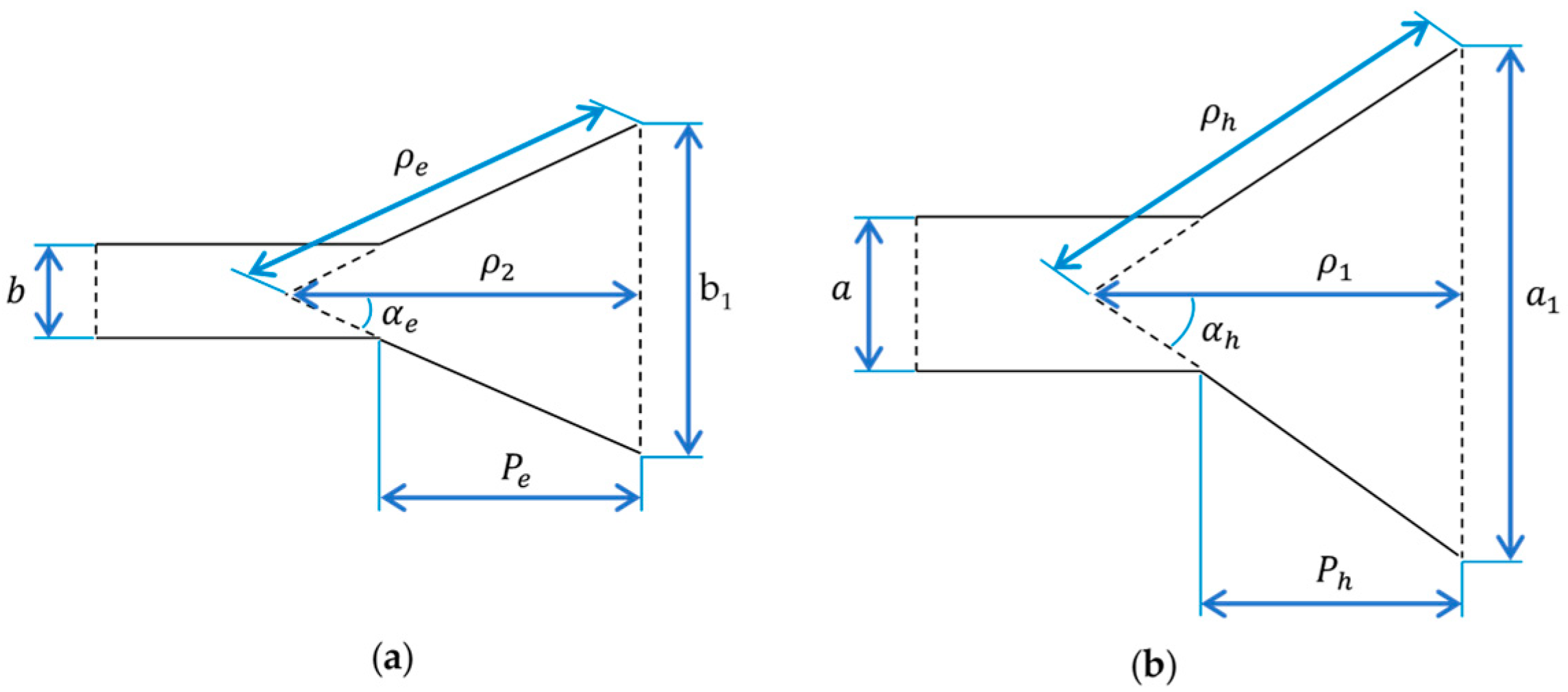


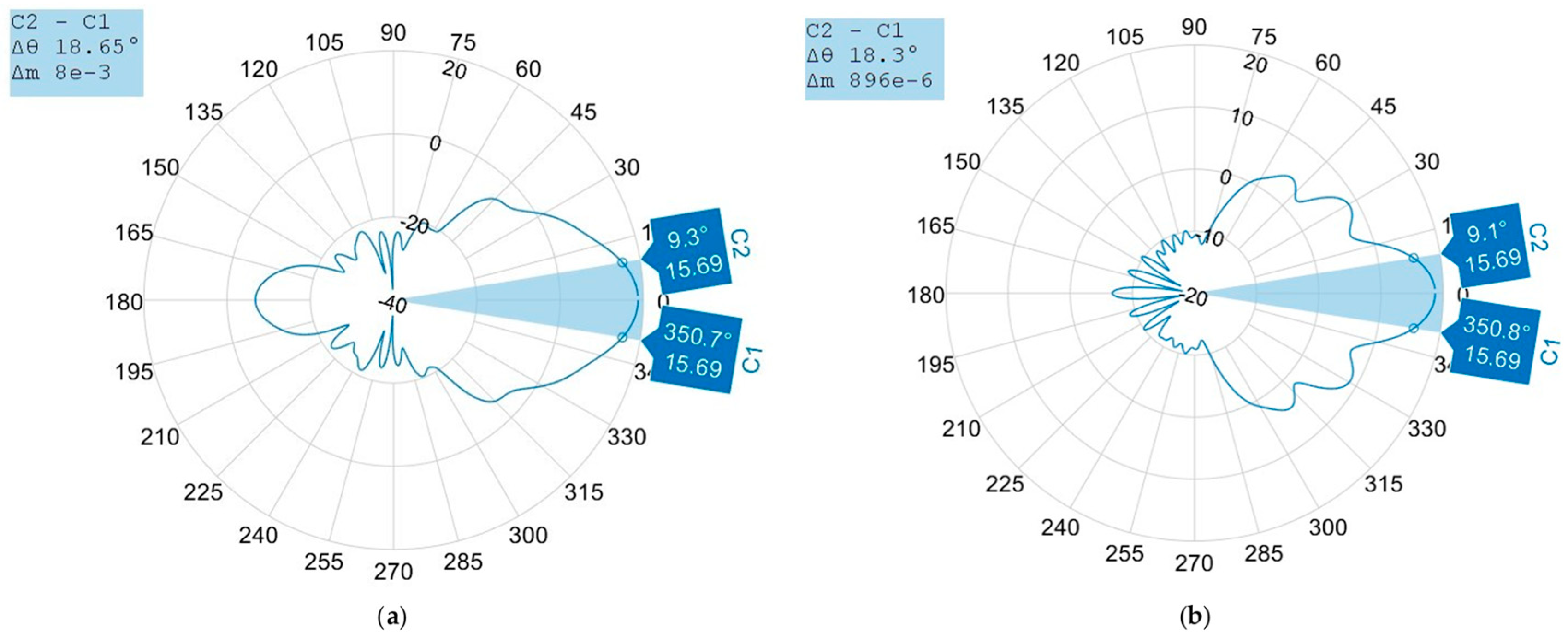
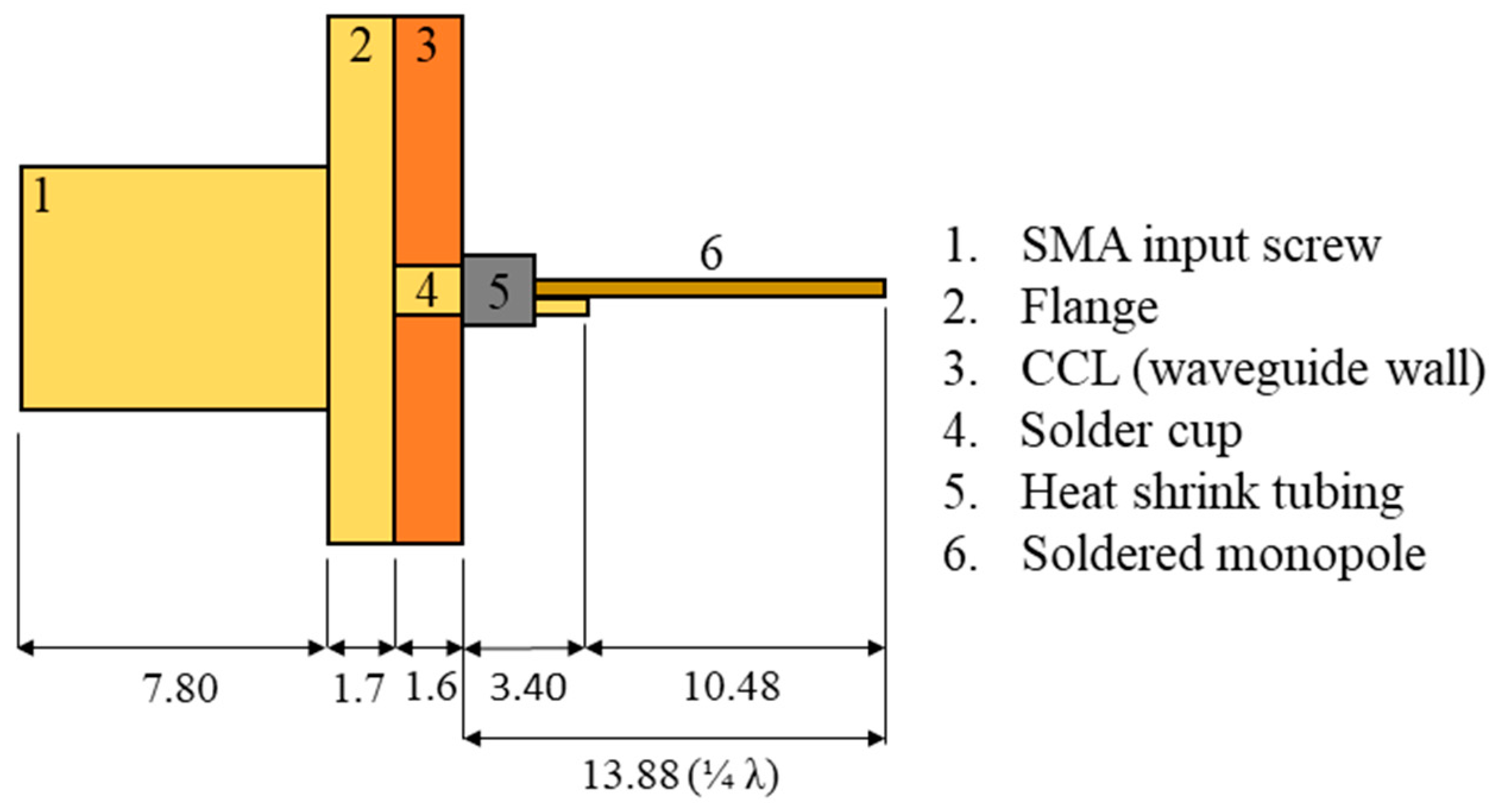

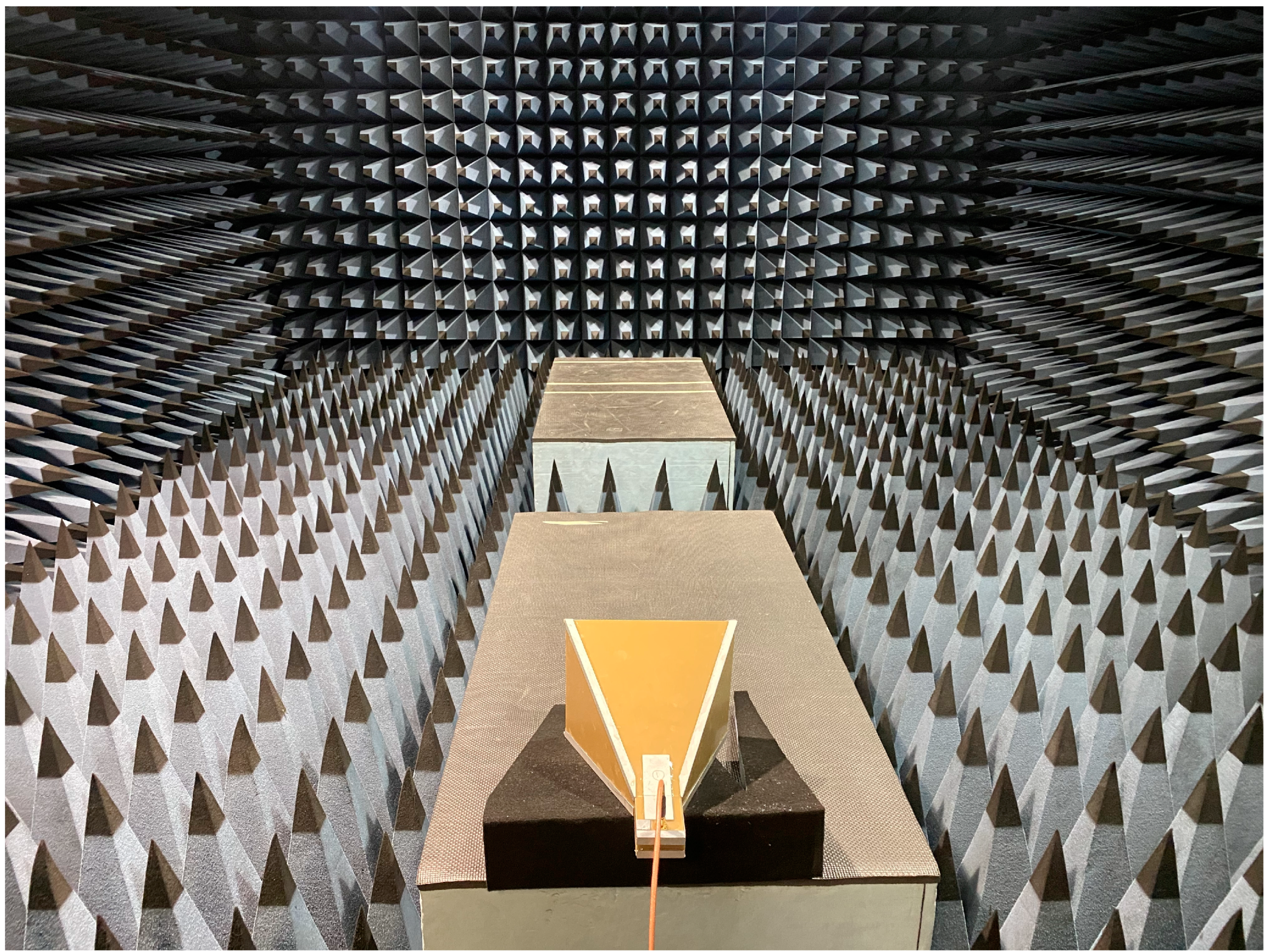

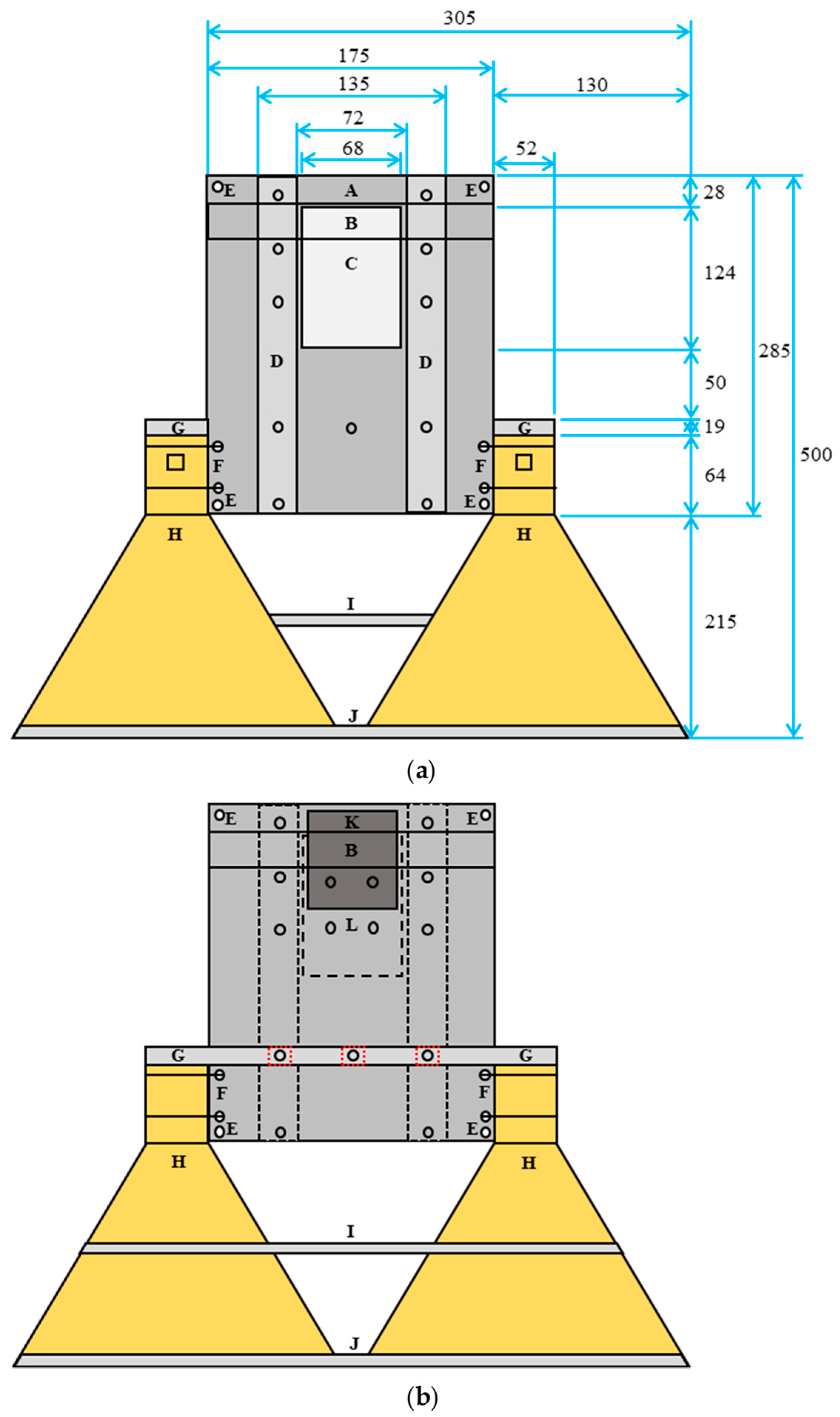
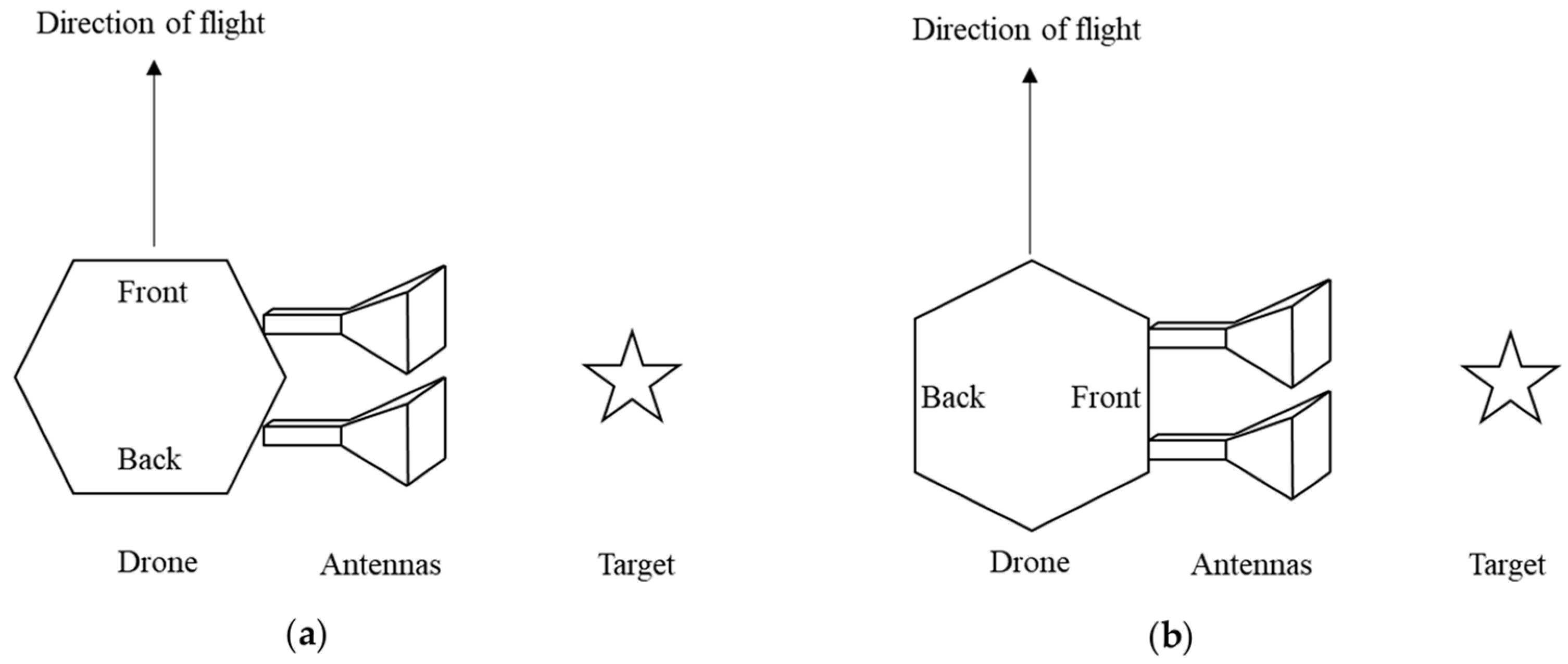
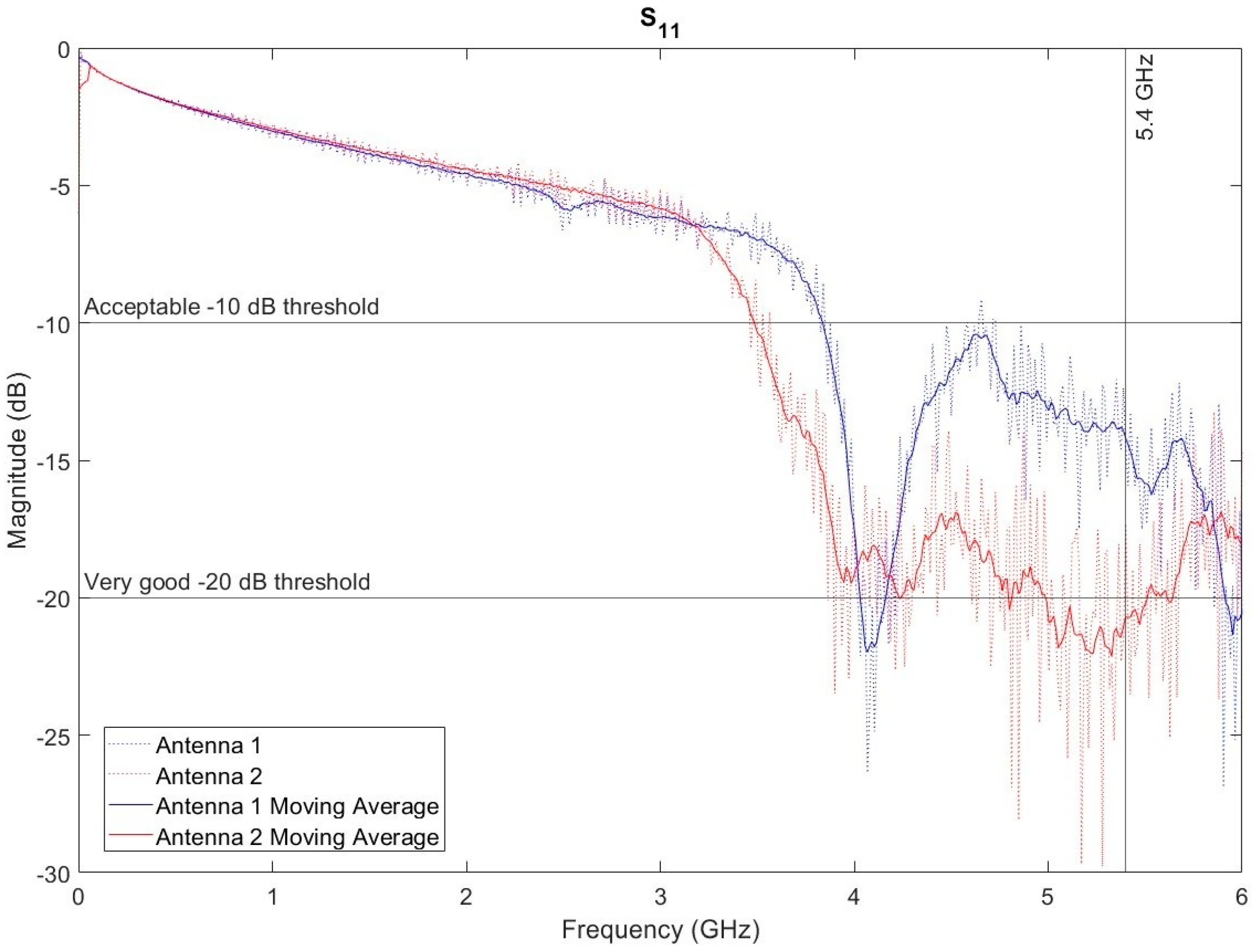
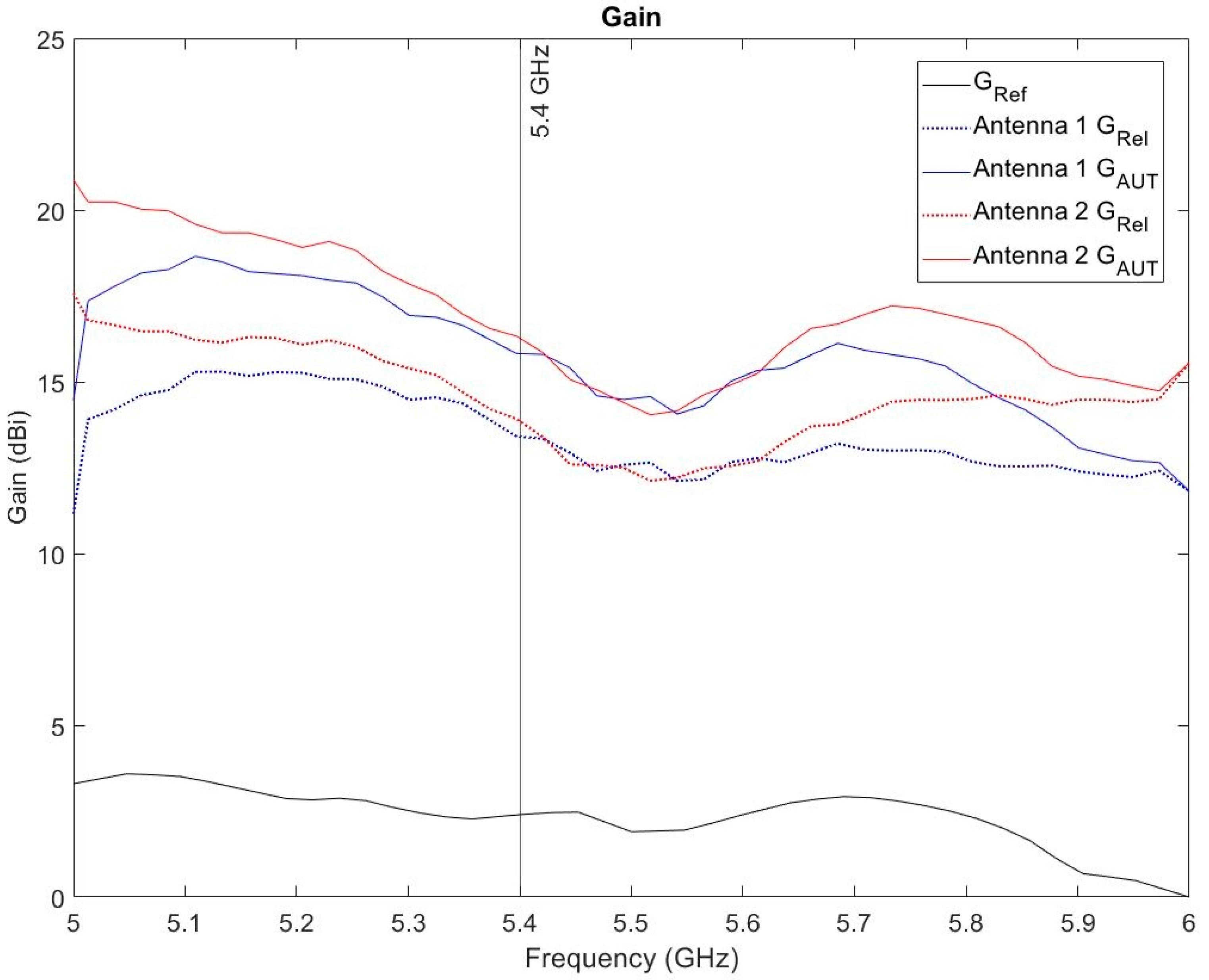
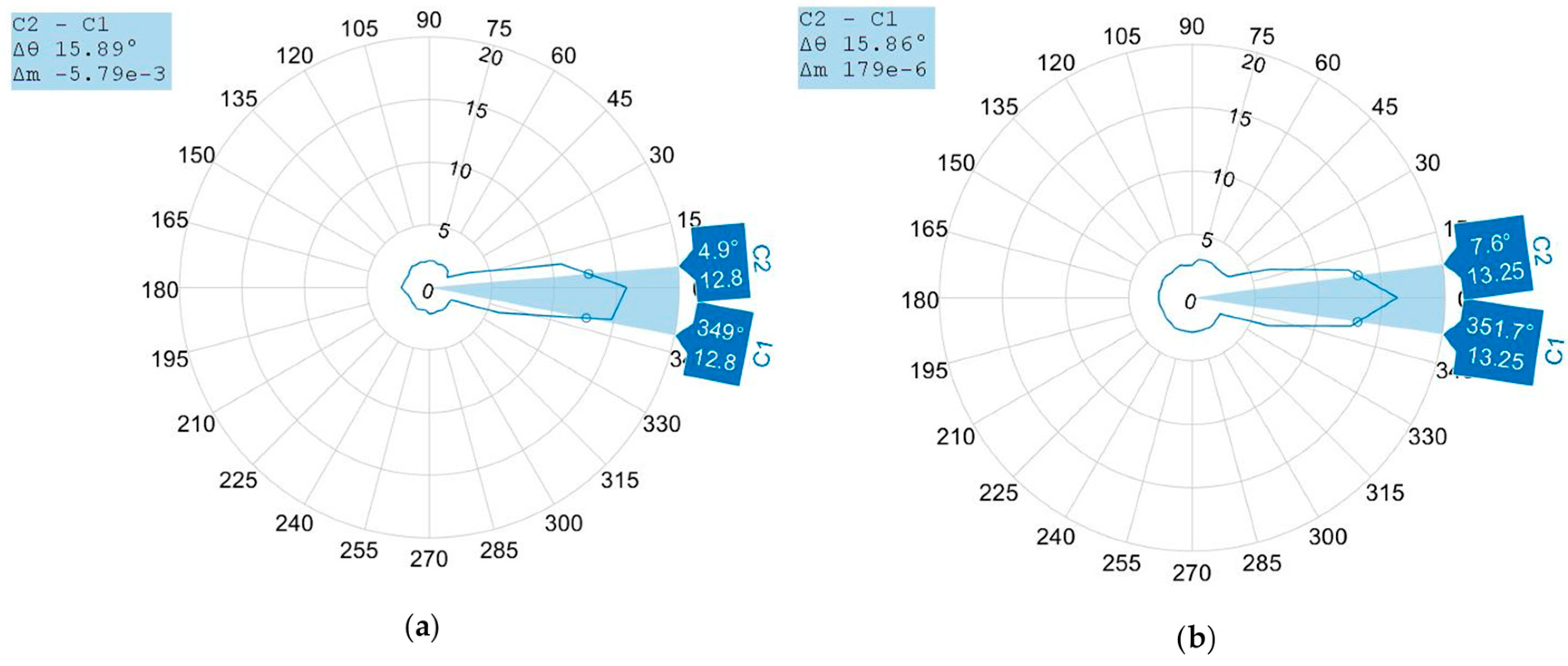



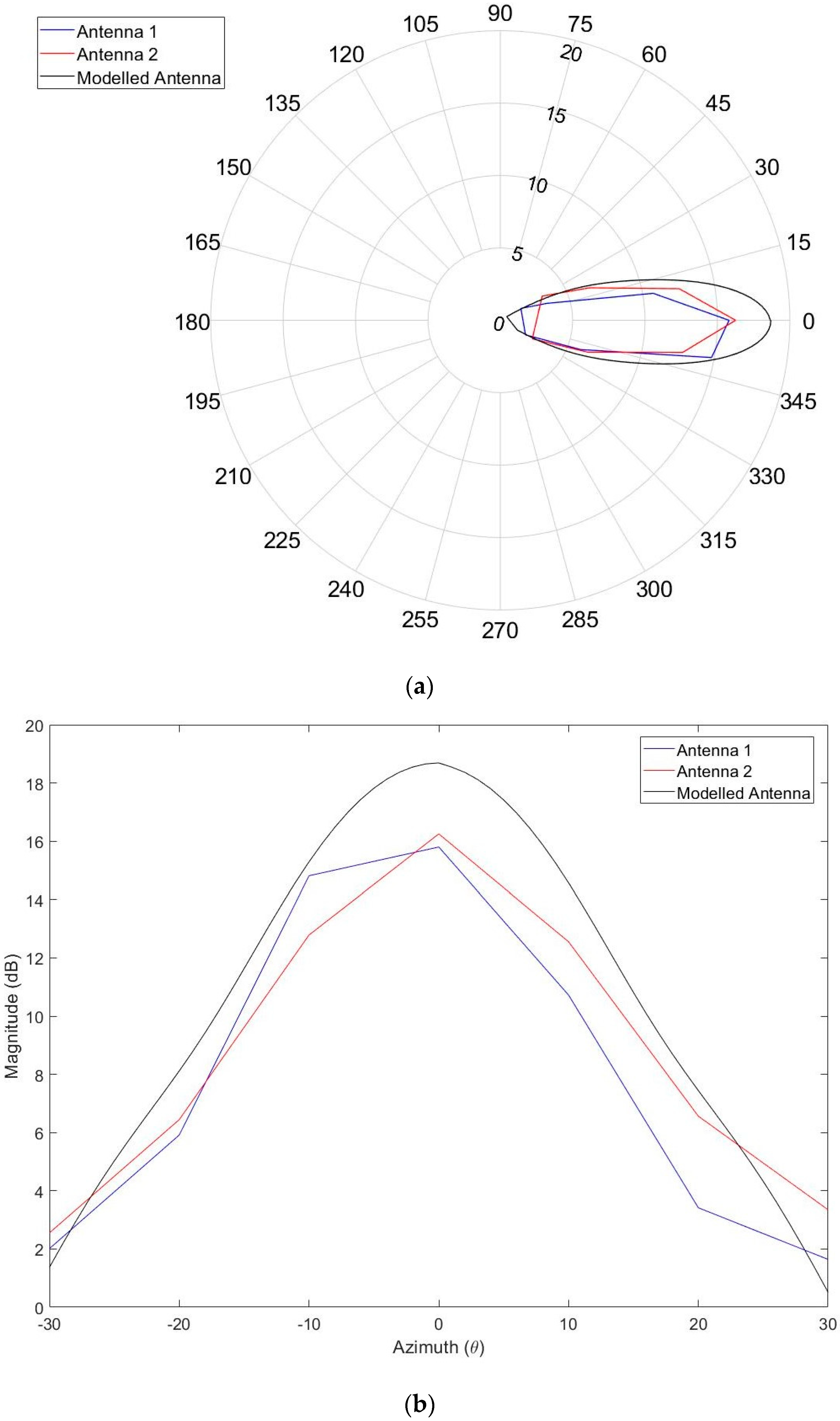
| Parameter | Length (mm) |
|---|---|
| 47.55 | |
| 22.15 | |
| 220.58 | |
| 169.42 | |
| 214.53 | |
| 214.53 | |
| 260.93 | |
| 294.89 |
| Annotation in Figure 10 | Feature | Description |
|---|---|---|
| A | Aluminium sheet | Main platform of the payload enclosure. 175 × 285 × 1 mm aluminium sheet. |
| B | Strap | Heavy-duty elasticated strap with silicone grips, to secure the Raspberry Pi to the underside of the aluminium sheet. |
| C | E312 | Mounting position for the Ettus USRP E312 and connection stabiliser. |
| D | Aluminium reinforcements | Two 32 × 285 × 6 mm aluminium pieces for reinforcement, with 4 screws. |
| E | Mounting holes | Mounting holes for screws, which align with the thread pillars on the underside of the DJI Matrice 600 Pro. |
| F | Cable ties | Holes with cable ties for securing the platform and antenna waveguides together. |
| G | Aluminium angle | 19 × 278 × 2 mm aluminium angle, connecting the platform and antenna waveguides, with three screws. Red boxes at the screw locations denote the position of three 19 × 19 × 24 mm aluminium blocks with 15° faces installed between the aluminium sheet and perpendicular aluminium angle, to achieve the desired viewing angle. |
| H | Antennas | CCL horn antennas. |
| I | Antenna braces | 19 × 355 × 2 mm aluminium antenna brace. |
| J | Two 19 × 450 × 2 mm aluminium antenna braces. | |
| K | Raspberry Pi | Raspberry Pi mounting case position. |
| L | E312 mount | Screw holes that align with the E312 mounting holes. |
| AUT | GRef (dBi) | GRel (dBi) | GAUT (dBi) | ||
|---|---|---|---|---|---|
| Antenna 1 | 2.40 | + | 13.40 | = | 15.80 |
| Antenna 2 | 13.85 | = | 16.25 |
Disclaimer/Publisher’s Note: The statements, opinions and data contained in all publications are solely those of the individual author(s) and contributor(s) and not of MDPI and/or the editor(s). MDPI and/or the editor(s) disclaim responsibility for any injury to people or property resulting from any ideas, methods, instructions or products referred to in the content. |
© 2023 by the authors. Licensee MDPI, Basel, Switzerland. This article is an open access article distributed under the terms and conditions of the Creative Commons Attribution (CC BY) license (https://creativecommons.org/licenses/by/4.0/).
Share and Cite
Carpenter, A.; Lawrence, J.A.; Ghail, R.; Mason, P.J. The Development of Copper Clad Laminate Horn Antennas for Drone Interferometric Synthetic Aperture Radar. Drones 2023, 7, 215. https://doi.org/10.3390/drones7030215
Carpenter A, Lawrence JA, Ghail R, Mason PJ. The Development of Copper Clad Laminate Horn Antennas for Drone Interferometric Synthetic Aperture Radar. Drones. 2023; 7(3):215. https://doi.org/10.3390/drones7030215
Chicago/Turabian StyleCarpenter, Anthony, James A. Lawrence, Richard Ghail, and Philippa J. Mason. 2023. "The Development of Copper Clad Laminate Horn Antennas for Drone Interferometric Synthetic Aperture Radar" Drones 7, no. 3: 215. https://doi.org/10.3390/drones7030215
APA StyleCarpenter, A., Lawrence, J. A., Ghail, R., & Mason, P. J. (2023). The Development of Copper Clad Laminate Horn Antennas for Drone Interferometric Synthetic Aperture Radar. Drones, 7(3), 215. https://doi.org/10.3390/drones7030215











